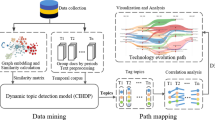Abstract
In the modern context, as the data generated is exponential, finding meaningful patterns from large datasets is an urgent need. A ‘Topic Evolution Model’ could generate the evolutions related to a topic of user interest and assist in the exploration of patterns. In a generic setting, the proposed ‘topic evolution model’ assist researchers and domain experts for the relevant information extraction on scientific field progress and innovations in technological field or domain from large archives. The evolution patterns uncover the emerging, decay/fading, peculiar, and long-lasting research topics and subtopics. The performance evaluation on coherence metrics asserts that the proposed model significantly minimizes the domain expert user efforts in topic analysis, as evolving patterns easily reveal underlying statistical and machine learning details. The perplexity metrics highlights the capability of the topic model toward the cognitive view of the user, i.e., change of ideas and knowledge through a period of time reducing the citation bias.
Access this chapter
Tax calculation will be finalised at checkout
Purchases are for personal use only
Similar content being viewed by others
References
D. Shahaf, C. Guestrin, E. Horvitz, J. Leskovec, Information cartography. Commun. ACM 58(11), 62–73 (2015). https://doi.org/10.1145/2735624
K. Li, H. Naacke, B. Amann, EPIQUE: extracting meaningful science evolution patterns from large document archives. in International Conference on Extending Database Technology (EDBT) (2020)
T.S. Kuhn, O. Neurath, The structure of scientific revolutions (2nd ed., enlarged ed.), in Number ed.-in-chief: Otto Neurath; Vol. 2 No. 2 in International Encyclopedia of Unified Science Foundations of the Unity of Science (Chicago University Press, Chicago, Ill, 1994). https://doi.org/10.1515/9781400831296-024
Google Scholar, https://scholar.google.com. Last accessed 20 Sept 2021
ArXiv.org, https://arxiv.org. Last accessed 20 Sept 2021
Q. He, B. Chen, J. Pei, B. Qiu, P. Mitra, L. Giles, Detecting topic evolution in scientific literature: how can citations help?, in Proceedings of the 18th ACM conference on Information and knowledge management (2009), pp. 957–966. https://doi.org/10.1145/1645953.1646076
D. Chavalarias, J. P. Cointet, Phylomemetic patterns in science evolution—The rise and fall of scientific fields. PloS One8, 2 (2013), e54847. https://doi.org/10.1371/journal.pone.0054847
D.M. Blei, A.Y. Ng, M.I. Jordan, Latent Dirichlet allocation. J. Mach. Learn. Res. 3, 993–1022 (2003)
P. Jaccard, The distribution of the flora in the alpine zone. 1. New Phytol. 11(2), 37–50 (1912). https://doi.org/10.1111/j.1469-8137.1912.tb05611.x
F. Martin, M. Johnson, More efficient topic modelling through a noun only approach, in Proceedings of the Australasian language technology association workshop 2015 (2015)
V. Andrei, O. Arandjelović, Complex temporal topic evolution modelling using the Kullback-Leibler divergence and the Bhattacharyya distance. EURASIP J. Bioinf. Syst. Biol. 1, 1–11 (2016). https://doi.org/10.1186/s13637-016-0050-0
Y. Jo, J.E. Hopcroft, C. Lagoze, The web of topics: discovering the topology of topic evolution in a corpus, in Proceedings of the 20th International Conference on World Wide Web (2011), pp. 257–266. https://doi.org/10.1145/1963405.1963444
Z. Tong, H. Zhang, A text mining research based on LDA topic modelling, in International Conference on Computer Science, Engineering and Information Technology (2016), pp. 201–210. https://doi.org/10.5121/csit.2016.60616
A. Salatino, F. Osborne, E. Motta, AUGUR: Forecasting the “Emergence of New Research Topics”, in ACM/IEEE on Joint Conference on Digital Libraries (ACM, New York, 2018), pp 303–312. https://doi.org/10.1145/3197026.3197052
A. Chaudhuri, N. Sinhababu, M. Sarma, D. Samanta, Hidden features identification for designing an efficient research article recommendation system. Int. J. Digital Libr. 1–17 (2021), https://doi.org/10.1007/s00799-021-00301-2
D. Cai, X. He, J. Han, Training linear discriminant analysis in linear time, in 2008 IEEE 24th International Conference on Data Engineering (2008), pp 209–217. https://doi.org/10.1109/ICDE.2008.4497429
Graphviz Homepage, https://graphviz.org. Last accessed 15 Sept 2021
Author information
Authors and Affiliations
Corresponding author
Editor information
Editors and Affiliations
Rights and permissions
Copyright information
© 2022 The Author(s), under exclusive license to Springer Nature Singapore Pte Ltd.
About this paper
Cite this paper
Adhav, H., Singh, V. (2022). Topic Evolution Model for Interactive Information Search. In: Nayak, J., Behera, H., Naik, B., Vimal, S., Pelusi, D. (eds) Computational Intelligence in Data Mining. Smart Innovation, Systems and Technologies, vol 281. Springer, Singapore. https://doi.org/10.1007/978-981-16-9447-9_12
Download citation
DOI: https://doi.org/10.1007/978-981-16-9447-9_12
Published:
Publisher Name: Springer, Singapore
Print ISBN: 978-981-16-9446-2
Online ISBN: 978-981-16-9447-9
eBook Packages: Intelligent Technologies and RoboticsIntelligent Technologies and Robotics (R0)




